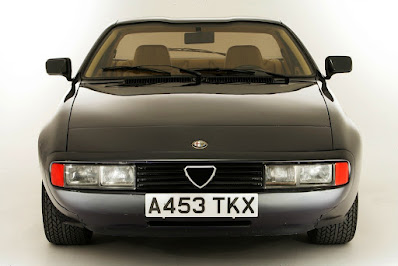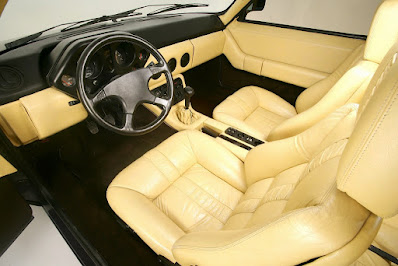⚠️Hidden ONES📢 - In the world of automotive innovation, few names evoke the sense of passion and creativity as strongly as Zoragy Studio. Established in Ljig, Serbia, Zoragy Studio has been pushing the boundaries of automotive design and engineering since its informal inception in 1982. The visionaries behind this pioneering company are Zoran Radivojević, a graduate civil engineer, and Ivan Obradović, a graduate industrial design engineer. Together, they have embarked on a journey that has seen Zoragy evolve from humble beginnings into a name synonymous with cutting-edge supercars.
 |
| This striking light blue Zoragy Roadster was featured in the music video 'Playa's Only' from R. Kelly's 2005 album, Reloaded. (Picture from: Depo.ba) |
Zoran's interest in automotive design began during his student years when he started working on prototype vehicles fueled by nothing more than love for the craft and the limited funds of a student’s budget. His first major project, completed in 1985, was a Buggy body prototype. This early endeavor laid the groundwork for what would become a lifelong pursuit of automotive excellence. Zoragy Studio’s evolution from these initial projects to the present day is a testament to the dedication and vision of its founders.
 |
| The international debut of the first Zoragy Roadster prototype, built on the turbocharged Toyota MR-2, took place at the 2005 Detroit Motor Show. (Picture from: Zoragy) |
One of the most significant milestones in Zoragy’s history occurred in 2005 when the studio unveiled its first prototype at the Detroit Motor Show. This two-seater, based on the turbocharged Toyota MR-2, was the result of two years of painstaking work by Zoran and his colleagues.
 |
| The cabin of the first Zoragy Roadster prototype is equipped with advanced features and a luxurious interior wrapped in tan and blue genuine leather. (Picture from: Zoragy) |
The vehicle's design was so well-received that it earned Zoragy Studio first place in a competition for hand-made cars, marking the studio’s entry into the global automotive scene. The success of this project also led to the addition of Ivan Obradović to the Zoragy team, further strengthening the studio’s design capabilities.
 |
| The 2007 Zoragy B092 Coupe, designed for the American market, was based on the Chevrolet Camaro and powered by a 400 hp engine. (Picture from: Zoragy) |
Zoragy’s reputation continued to grow, particularly after one of its vehicles was featured in a music video by the American artist R. Kelly back in 2005. The car, a striking light blue roadster, appeared alongside luxury brands such as Mercedes, Ferrari, and Rolls-Royce, yet it stood out for its unique design and presence. This appearance in the video not only brought international attention to Zoragy but also sparked widespread discussions among car enthusiasts, further cementing the studio’s reputation as a creator of extraordinary vehicles.
 |
| The 2007 Zoragy B092 Coupe designed for the local Serbian market, was based on the Toyota Supra, with engines ranging from 240 to 330 hp. (Picture from: Zoragy) |
Following this success, Zoragy Studio continued to produce innovative vehicles, including a coupe version for the American market in 2007. This model was based on the Chevrolet Camaro and was powered by a 400 hp engine. For the Serbian market, the studio offered versions based on the Toyota Supra, with engines ranging from 240 to 330 hp. Zoragy’s use of composite materials, glass, and plastic in their construction demonstrated the studio’s commitment to lightweight, durable designs that performed at the highest levels.
Today, Zoragy Studio is focused on its latest ambitious project: the Zoragy E+. This 2-seater hybrid supercar is built on the Honda NSX platform and combines the power of a gasoline V6 engine with the efficiency of an electric motor. The Zoragy E+ is a reflection of the studio’s ongoing commitment to innovation,
blending traditional automotive engineering with modern hybrid technology. The car’s impressive performance, including an acceleration time from 0 to 100 km/h in just 2.3 seconds, positions it as a formidable contender in the supercar market.
Despite the challenges faced along the way, including significant financial constraints, Zoragy Studio remains a beacon of creativity and innovation in the automotive world. The founders, Zoran and Ivan, continue to seek investment to bring their latest creations to life, demonstrating their unwavering dedication to their craft. Zoragy’s journey from a small, informal workshop to an internationally recognized name is a story of perseverance, talent, and a relentless pursuit of excellence. | | |
| The 2011 Zoragy E+ Concept is a 2-seater hybrid supercar built on the Honda NSX platform, combining a gasoline V6 engine with an electric motor for enhanced efficiency. (Picture from: Zoragy) |
 As Zoragy Studio moves forward, the automotive world eagerly awaits the next chapter in its remarkable story. The legacy of Zoragy is one of innovation and passion, a legacy that will undoubtedly continue to inspire and excite for many years to come. *** [EKA | FROM VARIOUS SOURCES | ZORAGY IN FACEBOOK | DEPO.BA | AUTO-MAGAZIN | DANUBIUS.FORUMSR ]
As Zoragy Studio moves forward, the automotive world eagerly awaits the next chapter in its remarkable story. The legacy of Zoragy is one of innovation and passion, a legacy that will undoubtedly continue to inspire and excite for many years to come. *** [EKA | FROM VARIOUS SOURCES | ZORAGY IN FACEBOOK | DEPO.BA | AUTO-MAGAZIN | DANUBIUS.FORUMSR ]Note: This blog can be accessed via your smart phone








































